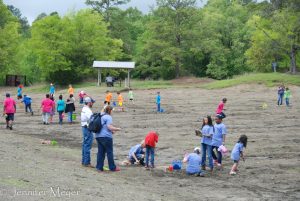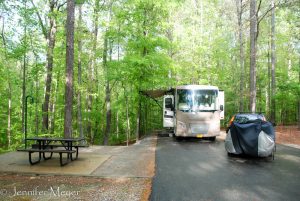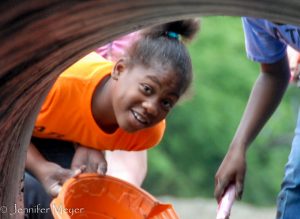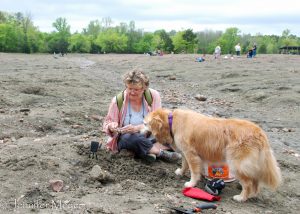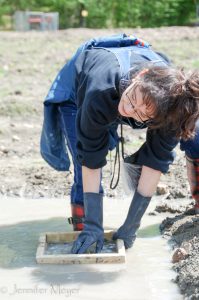Crater of Diamonds State Park, near Murphreesburough, Arkansas, includes an active diamond field. This is the only public land in the country where you can actually search for diamonds and keep whatever you find. Kate is a big rock hound and she loves sparklies, so this stop was a must.
The Campground
We were happily surprised by this state park campground. All the sites were nicely appointed with full hook-ups, patio slabs and new tables, nestled just enough into the trees to offer a little privacy. The woods were bright with spring green, and the place was peaceful and gorgeous.
After a quick setup, we grabbed an early lunch and headed straight to the diamond field to search for jewels. But when we returned, we took the fur kids on a 1.2 mile hike (that’s a lot for a cat) down to the Missouri River. We took the windy paved path down (wheelchair-accessible) and the natural dirt trail back up. Both were beautiful, and the paved path included a couple of “adult playgrounds” with instructions for exercises and stretches.
The Diamond Search
There’s an $8 daily fee to access the diamond field, but that doesn’t deter crowds of families and individuals in search of fortune. On this day, there were hundreds of school kids on a field trip, and their screeching chatter filled the air. Dogs are allowed, so we brought Bailey with us, and we went to the far side where there were fewer people.
The field is over 37 acres. It’s actually a volcanic crater, eroded over centuries. The first diamond here was found by a farmer in 1906, and this triggered a local “diamond rush.” During the early part of the centuries, several private and public mines were opened and hundreds of diamonds were found, including a 40-caret piece, the biggest ever found in the United States.
In 1972, the state of Arkansas bought this particular piece of land from private owners who had never successfully mined it. It was turned into a state park, and visitors have been searching for and finding diamonds there ever since. The week before we were there, several multi-caret diamonds had been found, as well as some large amethyst. The field is plowed regularly to unearth more stones, and the best time to search is after a heavy rain.
There are two ways to mine field diamonds. The easiest way is dry-mining. You can walk up and down the plowed rows and just train your eyes on the rocky earth, searching for the bright, semi-translucent stones that are uncut diamonds. Or you can use a trowel or shovel to dig and sift through the dirt. With the wet mining technique, you use buckets and sifters to dip clumps in water, separating dirt from stone. You can rent all the necessary equipment at the park, or come with your own. We chose the simpler dry method, and we came equipped with our own trowels and bucket.
We spent about four hours hunched over the ground, digging and hand-sifting. The diamonds found here are semi-transparent white, brown, and yellow. We found a couple of stones we thought could be diamonds. And Kate found many pretty rocks to add to her collection. But when we returned to the Visitor Center late in the afternoon, the center’s gemologist, available to identify all visitors’ stones, gave us the disappointing news. I think they were a piece of crystal and an agate. Guess we won’t be returning home with more money than we left with.

